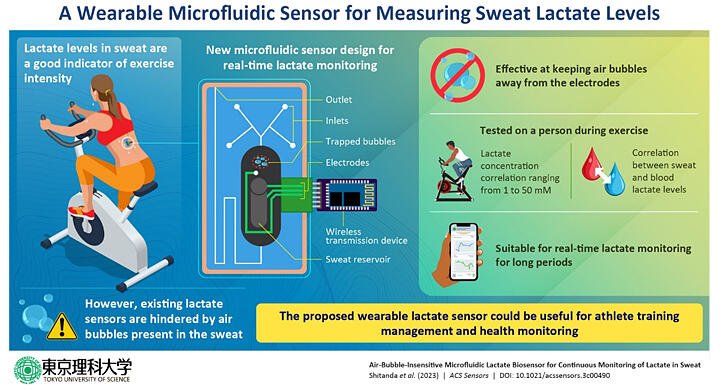A research group led by Associate Professor Isao Shitanda at the Department of Pure and Applied Chemistry of the Faculty of Science and Technology, Professor Masahiro Motosuke at the Department of Mechanical Engineering of the Faculty of Engineering, Associate Professor Tatsunori Suzuki at the Department of Pharmacy of the Faculty of Pharmaceutical Sciences, Professor Shinya Yanagita of the Institute of Arts and Sciences, and Associate Professor Takahiro Mukaimoto of the Institute of Arts and Sciences at Tokyo University of Science has successfully developed a biosensor to monitor lactate concentrations in sweat. This biosensor can continuously and stably monitor the lactate concentrations present in sweat by trapping air bubbles within its microchannels. The study results have been published online in ACS Sensors.

Generally, the presence of lactate in sweat and blood is an indicator of physical activities such as exercise or training. Previously, several wearable devices capable of conveniently monitoring lactate concentrations from sweat have been developed. However, during the operations of these devices, air bubbles entering the microchannels have been observed to establish contact with the electrode, leading to unstable sensor responses. The research group has been working toward the development of a wearable device capable of long-term monitoring of lactate concentrations from human sweat in a nonintrusive and stable manner.
In their study, a reservoir was introduced into the microchannel of a lactate sensor to trap any air bubbles that may have entered the sensor. Generally, within such a sensor device, sweat enters from four different inlets and establishes contact with the electrode, allowing lactate detection. The sensor design is such that old sweat is discharged through an outlet with the continuous entry of new sweat. The reservoir introduced within the microchannel traps any air bubbles that may enter along with sweat, ensuring that the bubbles do not establish contact with the electrode.
With this device design, even if bubbles were to enter the sensor, their possible contact with the electrode is suppressed, enabling continuous and long-term monitoring of lactate concentrations. Experiments were conducted by attaching the developed sensor to a human subject, and continuous monitoring of lactate levels was demonstrated.
Further developments in this direction are expected to promote facile applications of wearable devices that can be used comfortably and for extended durations during athletic training or patient rehabilitation.
Journal Information
Publication: ACS Sensors
Title: Air-Bubble-Insensitive Microfluidic Lactate Biosensor for Continuous Monitoring of Lactate in Sweat
DOI: 10.1021/acssensors.3c00490
This article has been translated by JST with permission from The Science News Ltd. (https://sci-news.co.jp/). Unauthorized reproduction of the article and photographs is prohibited.




